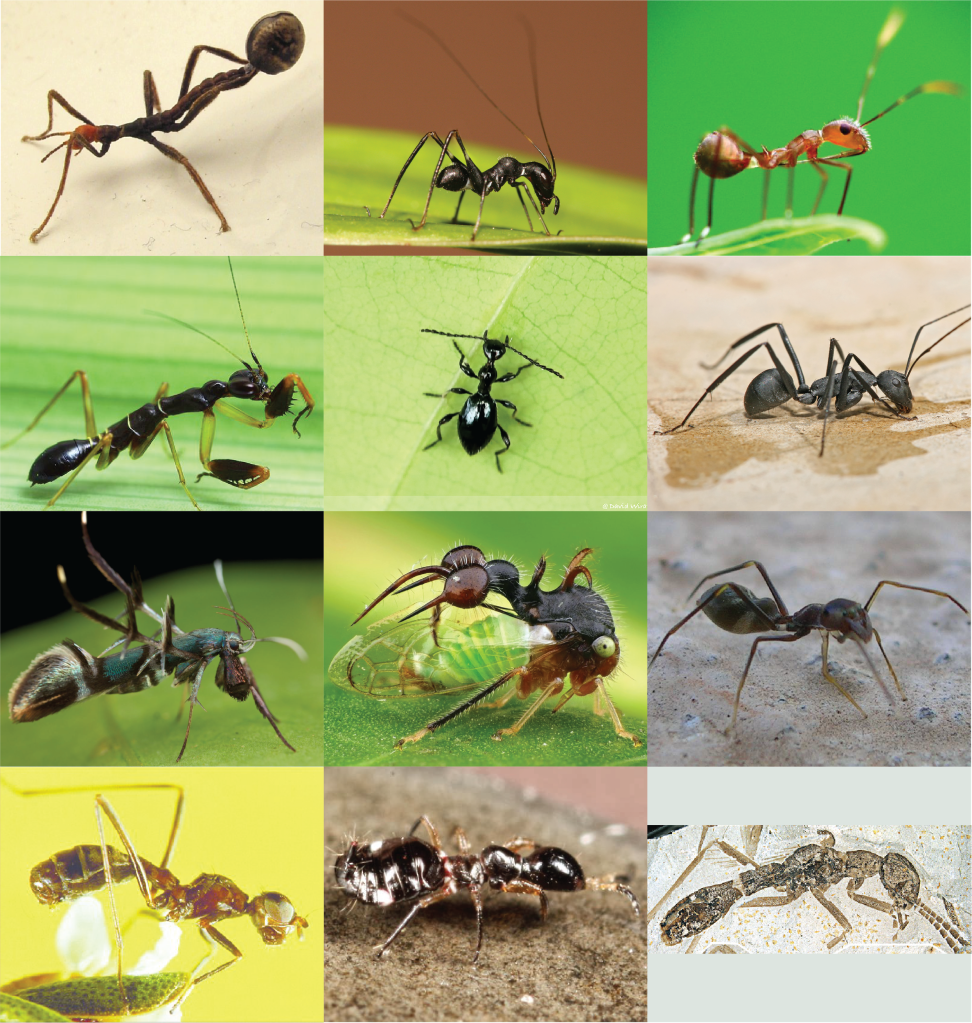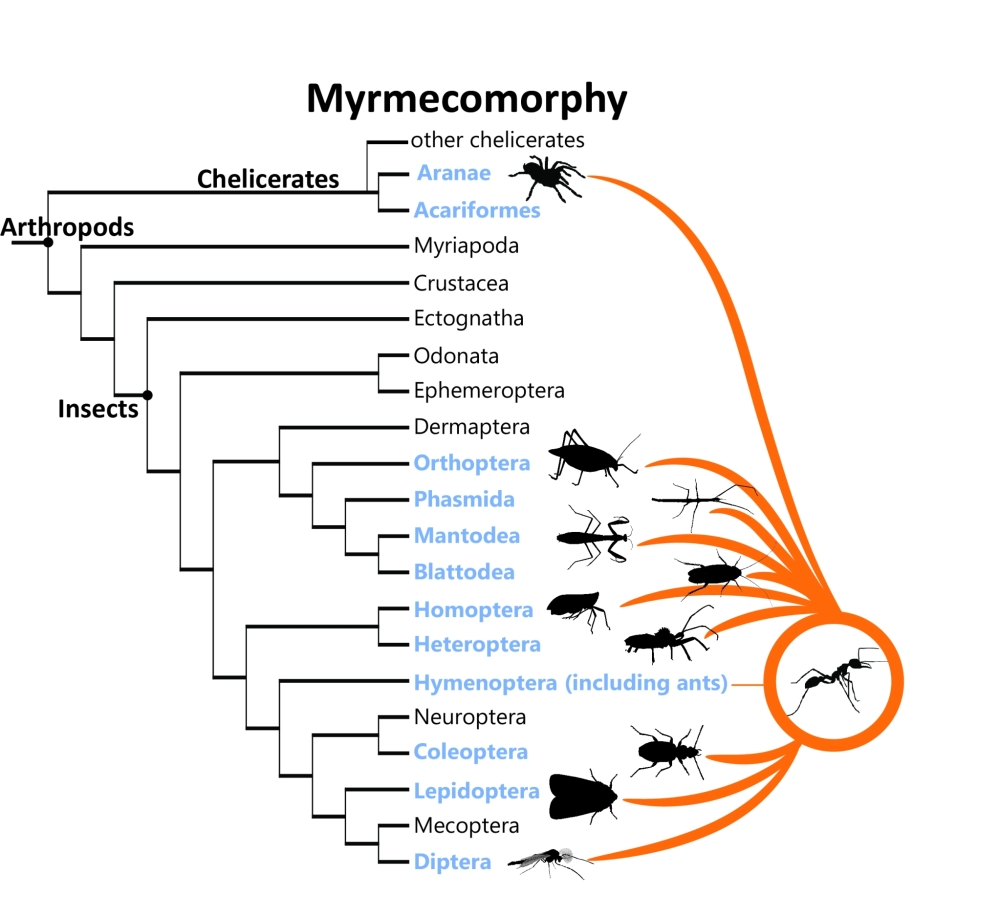Take a look at this image and answer: how many ants are there?

The answer may surprise you: among all of these arthropods, only one of them is an ant (find the answer at the end of the article).
Evolution is an extremely powerful force able to shape different features into the same morphology multiple times. The fins of fishes, dolphins or ichthyosaurs, for example, have all adapted for aquatic locomotion, despite happening in very different groups of animals.
Among arthropods, the group that encompasses crabs, shrimps, insects or spiders, one of the most popularized cases of convergent evolution is carcinization, or the idea that everything evolves into a crab. Through carcinization, several crustaceans, mainly hermit (anomurans) and true crabs (brachyurans) have evolved into a crab-like shape. Carcinized crustaceans have short, flattened bodies and large pincers, an anatomy that has appeared multiple times independently. But there is in fact, a more widespread, impressive case of convergent evolution in arthropods, a process in which many groups have evolved into ants: “myrmecomorphy”.
Why do arthropods keep evolving into ant-like shapes, and why?
Ants have had a major impact on Earth’s history.
Ants appeared over 100 million years ago, in the Jurassic period. Since then, they have conquered all continents but Antarctica, diversified into more than 14000 species and multiplied to reach a global population of over 20 billion individuals, accounting for more biomass than all birds and wild mammals combined.
Ants have also created some of the most complex societies on Earth. These societies include highly specialized casts, efficient teamwork, mushroom-based crops, and farming practices. Ants are also notorious for their defence systems, including collaborative biting and chemical defences that make them unpalatable or poisonous. Living in an ant society, then, can provide any arthropod with huge benefits.
More than 2000 species, encompassing not one or two, but over 13 major arthropod groups, from spiders to praying mantises, to crickets or butterflies have species that have taken advantage of the ant evolutionary success and have evolved shapes and behaviours to get integrated into ant societies.
Just as a stick insect has evolved to closely mimic a twig, all these species have evolved into an ant-like shape, thus becoming “myrmecomorphic”, or ant mimics. The abundance of ants and the advantages their society provides are responsible for the success of the myrmecomorphic strategy. But which are those advantages?

Why is looking like an ant advantageous?
South American beetles of the genus Ecitomorpha have evolved an ant-like shape that allows them to fool their model: Eciton ants, a process known as Wasmannian mimicry. With their ant-like appearance, Ecitomorpha can live just like any other ant, but without contributing to the colony’s workforce. Instead, they forage on any food the ants have lost or left unattended. These beetles also follow the ant’s migration and let themselves be carried on top of food or larvae that are being transported.
Wasmannian mimicry can also be used in other, more aggressive ways. Multiple lineages of spiders have also evolved into ant-like morphologies or produce ant-like chemical compounds, with one primary goal: hunting. Spiders can infiltrate ant societies through their ant-like appearance to capture different inhabitants, from ants to aphids, which are farmed to produce honeydew. But Wasmannian mimicry is not as common as another type of strategy: Batesian mimicry.
Ants are difficult prey: their cooperative aggression and their chemical defences give them multiple tools to fend off predators. However, not all animals have evolved these tools. Defences like poisons or bright colours are energetically costly and can hinder other facets of an animal’s life history, like growth or the number of offspring.
Many animals, instead, use Batesian mimicry. In Batesian mimicry, an animal mimics a dangerous prey, without being dangerous itself. While Batesian mimicry happens across many species, from coral snakes to hoverflies, there are few cases in which so many different species use on single group as their Batesian model as ant-mimicry. Thousands of arthropods acquire an ant-like morphology just to fool and fend off predators. The advantages of looking like an ant are so high, that a single arthropod species may mimic not one, but multiple ant species during its different growth stages.
One example of a Batesian mimic is the heteropteran (true bug) Hyalymenus. While adult Hyalymenus looks like any other heteropteran, its larvae are almost identical to ants and can fool predators like the praying mantis Oxyopsis, which is usually found in the same plants. But ant-mimicking has not always evolved for defence.
Aggressive ant mimics try to fool ants to infiltrate their nests. Their goal is to hunt upon any weak target, either this being an ant or the many other inhabitants of the colony, such as the honeydew-making aphids that the ants rear. Many aggressive mimics are spiders and have had to experience major changes in their morphology to acquire a more insect-like appearance. Ant mimics, then, may not be as good as insect mimics. This is especially relevant when trying to fool other ants, as many rely on chemoreception to recognize their peers, rather than on vision. Can the perfect mimic ant-mimic ever exist?
Alternative ant mimic strategies and the limits of evolution.

Evolution has managed to shape the morphology of butterflies, grasshoppers or stick insects into stereotypical ant features. Most ant-mimics share common ant-like traits: club-shaped antennae, a rounded head with large eyes and mandibles, reduced or absent wings, long legs, a waist separating the thorax from the abdomen or a brown to black colour. But not all traits can be changed to resemble ants.
Structures like the piercing mandibles of true bugs or the strong hindlegs of grasshoppers remain present even in the best mimics. Insects also have the additional challenge to reduce a highly conspicuous and useful structure: wings Many insects, in fact, are ant-mimics before they reach adulthood, as nymphs and larvae are wingless.
Ant-mimicking spiders face even more challenges. Their body is not composed of three segments, but two (prosoma and opisthosoma), they do not have antennae and have five pairs of walking legs, instead of three. Many spiders use their second pair of legs as fake antennae; they wave them in the air just like antennae and even have hairs on the tips that give them an additional club-like shape. The prosoma is usually constricted, given the illusion that there is a head and a thorax. Legs are also elongated, and many spiders even have a dark spot that simulates a large eye. For highly different arthropods, like the acari Periperes, looking like adult ants is completely out of reach, but looking like ant larvae, with their grub-like appearance, is much easier.
Any innovation is restricted by evolutionary history, and large morphological changes require hundreds of millions of years. Any change in morphology also comes with trade-offs. Looking exactly like an ant may allow a spider to easily infiltrate a nest, but by doing so, it would lose all the spider-like features that make them an excellent hunter. Evolution must find a middle ground, and thus morphological mimics are never perfect. But there is something easier to change, and always changes faster: behaviour.
Open questions: Why do some groups have mimics, while others don’t?
Many ant-mimics are also masters of behavioural deceit. Ants have a very unique way of moving: they are usually walking at a constant pace, and do quick stops to share food or pheromones with their fellow workers. The spider Myrmaplata plataleoides, may not be the best morphological ant-mimic, but its walking speed and movement replicate an ant’s with precision. Many ants have a unique rugose pattern that can be used to recognize each other.
Several ant-mimics have evolved similar rugose patterns that can deceive this communication system, but a more original alternative is “shielding”. Rather than evolving this type of cuticle, the spider Aphantochilus uses carcasses of previous prey as a “shield” when approached by other ant workers, who apparently let themselves be fooled by this cheap trick. The strategy of Amyciaea forticeps is even more subtle; this ant-mimic spider pretends to be dead and captures any ant worker sent to help.
These different strategies, from morphology to behaviour highlight how evolution works. Not through a carefully detailed plan, but through creativity that needs to overcome many historical from functional constraints.
Myrmecomorphy is one of the most striking cases of convergent evolution in invertebrates. Things may not have really evolved into crabs but have certainly evolved into ants.
*The ant is in the second row, right picture. The remaining are ant mimics belonging to the following groups (from upper row to lower row, from left to right): Phasmatodea (Extatosoma tiaratum, Wikipedia), Orthoptera (Macroxiphus sp. Wikipedia), Heteroptera (coreid bug nymph, Wikipedia), Mantodea (unknown, Eddy Lee), Coleoptera (Anthelephila, Singapore Geographic), The ant (Camponotus sp., Wikipedia), Lepidoptera (Xestocasis, Paul-flickr), Homoptera (Cyphonia clavata, Maderspacher et al., 2011), Araneae (Myrmerachne, Wikipedia), Diptera (Badisis sp., Yeates et al., 2009. Brill), Thysanoptera (Compsothrips sp., Charley Eiseman), Blattodea (Grant viridifluvius, Vršanský et al., 2018).
References
-Maderspacher. F., & Stensmyr, M. (2011). Mymecomorphomania. Current Biology, R291-R293
-Mclver, J. D., & Stonedahl, G. (1993). Myrmecomorphy: morphological and behavioral mimicry of ants. Annual Review of Entomology, 38(1), 351-377.
-Nelson, X. J., & Jackson, R. R. (2012). How spiders practice aggressive and Batesian mimicry. Current Zoology, 58(4), 620-629.
-Pérez-Espona, S., Goodall-Copestake, W. P., Berghoff, S. M., Edwards, K. J., & Franks, N. R. (2018). Army imposters: diversification of army ant-mimicking beetles with their Eciton hosts. Insectes sociaux, 65, 59-75.
-Subramaniam, N., Tamma, K., & Uma, D. (2023). An arachnid’s guide to being an ant: morphological and behavioral mimicry in ant-mimicking spiders. Behavioral Ecology, 34(1), 99-107.
-Vršanský, P., Bechly, G., Zhang, Q., Jarzembowski, E. A., Mlynský, T., Šmídová, L., … & Wang, B. (2018). Batesian insect-insect mimicry-related explosive radiation of ancient alienopterid cockroaches. Biologia, 73, 987-1006.

One Comment Add yours